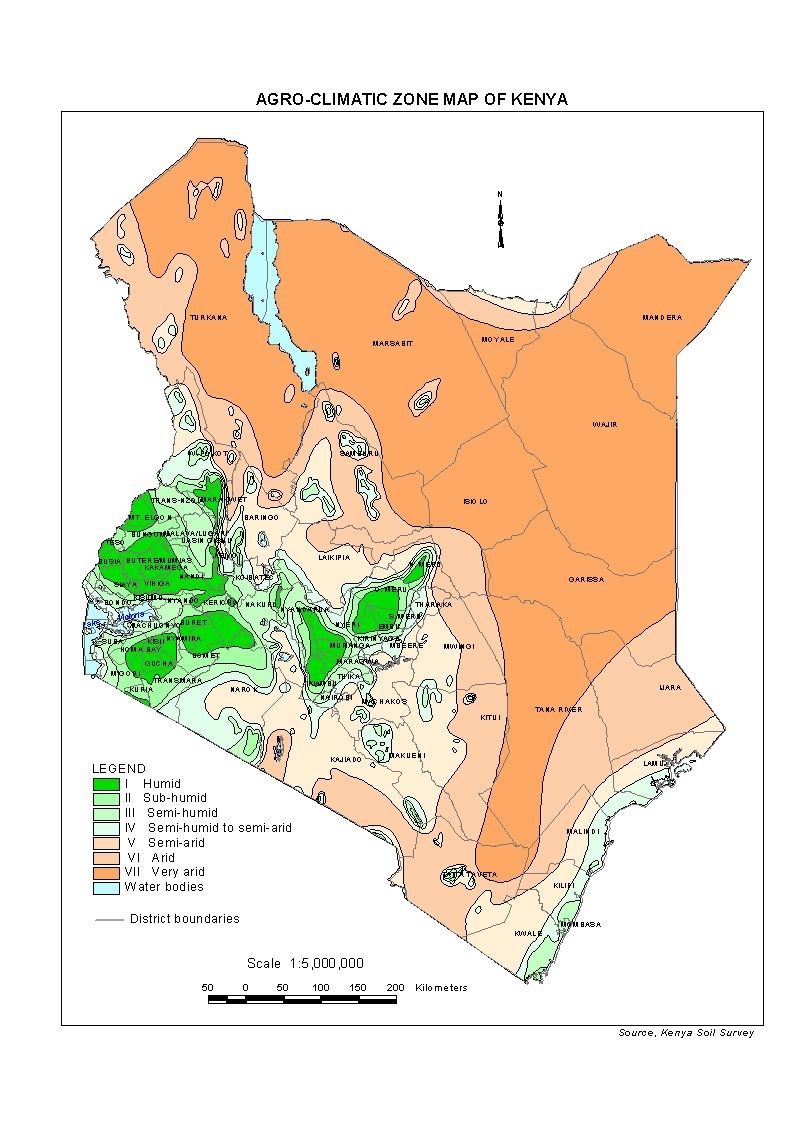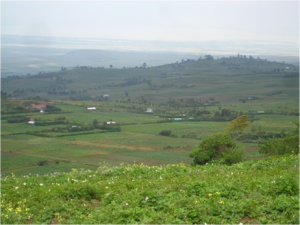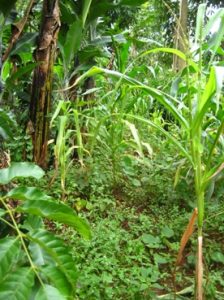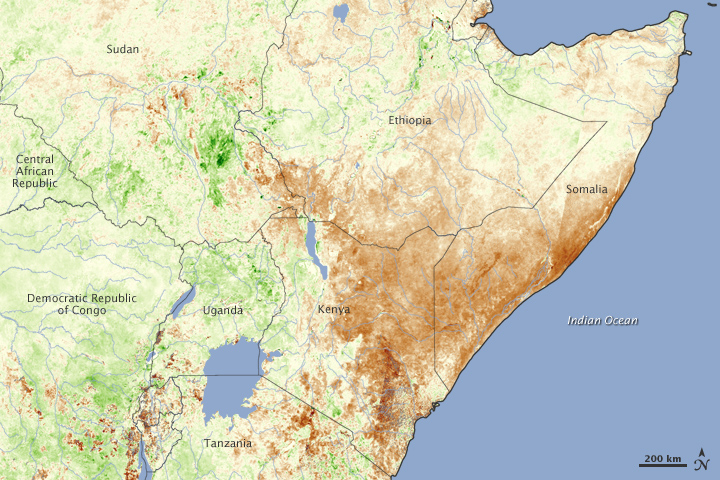71 Traditional Agriculture in Kenya
Rick Bein
F. L. (Rick) Bein
Department of Geography, IUPUI, USA
Gilbert M. Nduru
Department of Geography, Moi University, Kenya
Introduction on Kenyan food context
Agriculture is the main stay of Kenya’s economy that employs over 75 percent of its labor force and is the lifeline for 85 percent of the population. It earns 60% of the countries foreign exchange. Agricultural production involves mainly mixed farming, the raising of crops and livestock. Cropping is more intensive in the high rainfall areas with maize being the main staple food crop and beans the most important legume. Coffee, tea, and sugarcane are major commercial crops. Seventy five percent of Kenyan agriculture is practiced by small holder farmers.
Climate
Kenya has a wide rage of climatic scenarios largely dictated by the highly diverse topography and moisture generating systems, hence creating a wide rage of agro-ecological zones. Two rainy seasons prevail in much of Kenya with the long rains normally occurring in March through May while the short rains come in September and October. Storms watering eastern Kenya are generated from the Indian Ocean while the Congo – Lake Victoria hydrologic system provides precipitation for western Kenya.
The high lands are well watered through orographic processes and the interior lowlands in the north are quite arid. The eastern and western high lands ranging from 1000 to 2500 meters in elevation receive abundant rainfall while experiencing cooler temperature with less evapo-transpiration. This results in varied agro-ecological zones that sustain a wide diversity of agriculture. See Table 1 and Figure 1.
| ACZ | I | II | III | IV | V | VI | VII |
| Class | humid | Sub-humid | Semi- humid | Some what dry | Semi- Arid | Arid | Very
Arid |
| Rainfall in mm | 1100-2700 | 1000-1600 | 800-1400 | 600-1100 | 450-900 | 300-450 | 150-300 |
Table 1: Kenya’s Ago-Ecological Zones. Divided into seven agro-climatic zones (ACZ) based on suitable area for growing major food and cash crops. Source: Kenya Soil Survey 1982.

Figure 1: Agro-climatic map of Kenya by Kenya Soil Survey 1982.
Intensity of Agriculture
Agricultural Intensity is pronounced in the rainy highlands where temperatures are persistently cooler, evaporation rates lower and the soil has been blessed with rich volcanic nutrients. The highlands are divided by the Great Rift Valley which drops down to 1000 meters above sea level. Nairobi, the capital resides above 2000 meters in the Eastern Highlands which include the heights of Mt. Kenya at just fewer than 6000 meters. Commercial agriculture abounds with cultivation of tea, coffee and specialty export vegetables and flowers. Altitudinal zones are pronounced.
The Western Highlands occupy the high volcanic plateau (2500 meters) that slopes downward to Lake Victoria at about 1400 meters. Agriculture here serves more of the domestic market with the production of maize, wheat and livestock although export crops of tea and sugar are also prominent. Within the Rift Valley (Figure 2), the rainfall declines and irrigation frequently supports commercial agriculture of various types. Livestock herding is more pronounced in the Valley.

Figure 2: Looking into the Great Rift Valley. Potatoes in foreground over an intensively farmed bench terrace. Photo by Rick Bein 2011.
Traditional agriculture prevails throughout the country and is composed of crops that are grown mainly for home consumption. Many of these crops have long traditions of cultivation that carry much knowledge and lore about their uses. Generally these are high nutrition foods that are eaten at home or traded locally. Many of these crops along with numerous wild plants are also used medicinally. Some of staples of western Kenya include sorghum, finger millet , arrow root, beans, black night shade, sweet potatoes, kale, and cow peas (Figure 3). Maize cake (ugali) is still a major component of the diet. Many greens that grow semi-wild are consumed as vegetables. What might be considered a weed in other circumstances us frequently eaten as a salad.

Figure 3: Mixture of vegetables. Photo by Rick Bein 2011
The farmers of Kenya make many claims for the medicinal value of black night shade, products of the neim tree, sodom apples and the fats of sheep, goats, chickens, and pigs. One product called “black jack” is highly prized for its blood clotting capacity. Every house hold lists several unique medical plants. See figure 4.
 Figure 4: Medicinal plant. Photo by Rick Bein 2011.
Figure 4: Medicinal plant. Photo by Rick Bein 2011.
Characteristics of Traditional Agriculture
One characteristic of traditional agriculture is the practice of growing the crops in a mix of crops and animals. This has been identified through out the tropics as polyculture, intercropping, agro-forestry and multi-story agriculture. See figure 5. The system provides food security as plants are maturing through out the year; the different crops have symbiotic relationships with each other providing pest control, trellises, shade and fertilizer.

Figure 5: Mix of grasses, pumpkins and pigeon peas. Photo by Gilbert Nduru 2011.
Observed Cropping Trends in Different Agro-ecological Zones
In recent years there has been increase in demand for different crops in Kenya. This has been a result of frequent crop failures and declining yields of the main staple crops of maize, beans and potatoes. More farmers are turning to growing traditional food crops such as millet, sorghum (figure 6), bananas, yams, greens and sweet potatoes. These are now becoming cash crops and are appearing more often in local markets and in restaurants.
 Figure 6: Sorghum is seen as a nutritious, drought resistant food staple. Photo by Gilbert Nduru 2011.
Figure 6: Sorghum is seen as a nutritious, drought resistant food staple. Photo by Gilbert Nduru 2011.
Seasonal Variations
The landscape can appear dramatically different depending on the season (Figure 7). Located on the equator there is no winter and seasonality is defined between “wet season” and “dry season”. Although these seasons are expected to occur at certain times, that frequently varies and it is most noted when the rainy season arrives late or is prolonged.

Figure 7: French Spot image shows the intensity of the dry season January 2011 The brown color (dry lands) dominates much of Eastern Kenya.
Impacts of Climate Change
Climatic variability is normally associated with shifts in rainfall patterns. This involves reduced amount of rainfall at a time when farming folks expect rains. Droughts produce crop failure, food shortage and lack of pasture land. People will be forced to leave their land in search of water and food. Excessive rainfall when its least expected results in Flooding and Destruction of property.
Changes in rainfall and temperature can have an effect on the Kenyan agricultural base. Most serious would be increasing temperatures which will impact dramatically the small elevation zones and force the adaptive agriculture up slope. Declining precipitation would impact the conventional food staple producing areas (maize and beans). The impacts would vary from zone to zone.
Conclusion
The advantages of traditional agriculture are multiple. Different crops mature at different times, ensuring food security during the year. Intercropping/polyculture farming practice reduces labor costs with regard to weeding and pest control while the different crops support each other with fertilization, shade and pest repellents. Wild products are available at different times of the year in the form of plants, roots, legumes and tubers. Some crop products and plants are medicinal. Most of the traditional crops are well suited to harsh climatic conditions currently prevalent over most parts of Kenya.
More study is required on the role of traditional food crops in ensuring sustainable food production and supply in Kenya and other parts of Africa. More research is necessary on the role traditional crops as sources of income. There is need for more research on the nutritional value of respective crops. There is a need for a framework for the promotion and protection of traditional farming that should involve farmers in policy development and marketing.

